in my recent project I am working with hardware side tessellation. The pipeline I want to implement should take a low poly mesh, tessellate it and apply a displacement map.
The Tessellation works fine and just as I expected it to look like. However, when I apply the displacement map in the tessellation evaluation shader I get an output which is somewhat random.
This is the output without displacement (I used the heightmap as a texture to verify whether my texCoords are accurate)

This is what I get when I enable my displacement (using the same texture for both coloring and displacement):

The shader code is as follows:
//VERTEX SHADER
#version 430
layout(location = 0) in vec4 vertex;
layout(location = 1) in vec4 normal;
layout(location = 2) in vec2 texCoord;
out vec3 vPosition;
out vec3 vNormal;
out vec2 vTexCoord;
void main() {
vPosition = vertex.xyz;
vNormal = normal.xyz;
vTexCoord = texCoord;
}
//TESS CONTROL
#version 430
layout(vertices = 3) out;
in vec3 vPosition[];
in vec3 vNormal[];
in vec2 vTexCoord[];
out vec3 tcPosition[];
out vec3 tcNormal[];
out vec2 tcTexCoord[];
uniform float innerTessLevel;
uniform float outerTessLevel;
void main(){
float inTess = innerTessLevel;
float outTess = outerTessLevel;
tcPosition[gl_InvocationID] = vPosition[gl_InvocationID];
tcNormal[gl_InvocationID] = vNormal[gl_InvocationID];
tcTexCoord[gl_InvocationID] = vTexCoord[gl_InvocationID];
if(gl_InvocationID == 0) {
gl_TessLevelInner[0] = inTess;
gl_TessLevelInner[1] = inTess;
gl_TessLevelOuter[0] = outTess;
gl_TessLevelOuter[1] = outTess;
gl_TessLevelOuter[2] = outTess;
gl_TessLevelOuter[3] = outTess;
}
}
//TESS EVAL
#version 430
layout(triangles, equal_spacing, ccw) in;
in vec3 tcPosition[];
in vec3 tcNormal[];
in vec2 tcTexCoord[];
out vec3 tePosition;
out vec2 teTexCoord;
uniform mat4 ModelViewProjection;
uniform mat4 ModelView;
uniform sampler2D texHeight;
void main(){
vec3 p0 = gl_TessCoord.x * tcPosition[0];
vec3 p1 = gl_TessCoord.y * tcPosition[1];
vec3 p2 = gl_TessCoord.z * tcPosition[2];
vec3 pos = p0 + p1 + p2;
vec3 n0 = gl_TessCoord.x * tcNormal[0];
vec3 n1 = gl_TessCoord.y * tcNormal[1];
vec3 n2 = gl_TessCoord.z * tcNormal[2];
vec3 normal = normalize(n0 + n1 + n2);
vec2 tc0 = gl_TessCoord.x * tcTexCoord[0];
vec2 tc1 = gl_TessCoord.y * tcTexCoord[1];
vec2 tc2 = gl_TessCoord.z * tcTexCoord[2];
teTexCoord = tc0 + tc1 + tc2;
float height = texture(texHeight, teTexCoord).x;
pos += normal * (height * 0.2f);
gl_Position = ModelViewProjection * vec4(pos, 1);
tePosition = vec3(ModelView * vec4(pos,1.0)).xyz;
}
//GEOMETRY
#version 430
layout(triangles) in;
layout(triangle_strip, max_vertices = 3) out;
uniform mat4 ModelView;
in vec3 tePosition[3];
in vec3 tePatchDistance[3];
in vec2 teTexCoord[3];
out vec3 gFacetNormal;
out vec2 gTexCoord;
void main() {
vec3 A = tePosition[2] - tePosition[0];
vec3 B = tePosition[1] - tePosition[0];
vec4 N = vec4( normalize(cross(A, B)) , 0.0);
gFacetNormal = N.xyz;
gTexCoord = teTexCoord[0];
gl_Position = gl_in[0].gl_Position; EmitVertex();
gTexCoord = teTexCoord[1];
gl_Position = gl_in[1].gl_Position; EmitVertex();
gTexCoord = teTexCoord[2];
gl_Position = gl_in[2].gl_Position; EmitVertex();
EndPrimitive();
}
//FRAGMENT
#version 430
layout(location = 0) out vec4 fragColor;
in vec3 gFacetNormal;
in vec2 gTexCoord;
uniform float lit;
uniform vec3 light;
uniform sampler2D texHeight;
void main() {
#ifndef ORANGE_PURPLE
vec3 color = gl_FrontFacing ? vec3(1.0,0.0,0.0) : vec3(0.0,0.0,1.0);
#else
vec3 color = gl_FrontFacing ? vec3(1.0,0.6,0.0) : vec3(0.6,0.0,1.0);
#endif
if (lit > 0.5) {
color = texture(texHeight, gTexCoord).xyz;
vec3 N = normalize(gFacetNormal);
vec3 L = light;
float df = abs(dot(N,L));
color = df * color;
fragColor = vec4(color,1.0);
}
else {
fragColor = vec4(color,1.0);
}
}
It would be nice if someone could help me on that one.